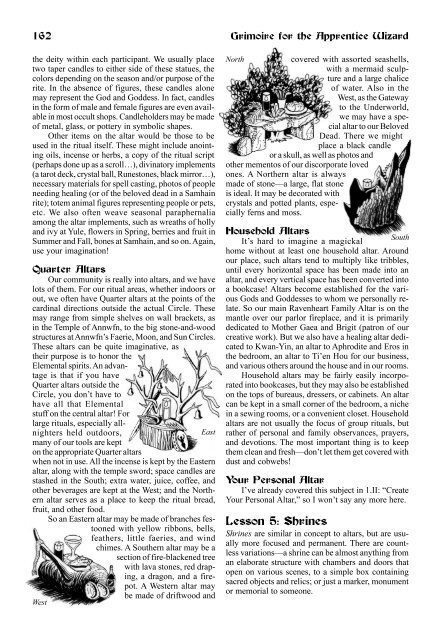Grimoire for the Apprentice Wizard
Create successful ePaper yourself
Turn your PDF publications into a flip-book with our unique Google optimized e-Paper software.
Course Four: Rites 161<br />
Lesson 3. Outdoor Circles<br />
Nature magick is meant to be per<strong>for</strong>med in <strong>the</strong> open<br />
air, in <strong>for</strong>ests and meadows, under starry skies, and<br />
around an open fire. When magickal rituals are regularly<br />
per<strong>for</strong>med in a wooded place, especially one<br />
remote from “civilization,” it will come alive in both<br />
obvious and subtle ways. Growing things will prosper;<br />
wild animals will find <strong>the</strong> area pleasing and appear<br />
in greater numbers. Those who are psychically<br />
sensitive will soon observe that <strong>the</strong>re is a definite<br />
charge or aura about <strong>the</strong> place, and often Faeries,<br />
wood-sprites, and o<strong>the</strong>r Nature spirits will be seen—<br />
first at night, and later even by day.<br />
My own magickal practice and tradition (HOME)<br />
evolved out in <strong>the</strong> country, during <strong>the</strong> eight years when<br />
our core people were living toge<strong>the</strong>r in a homesteading<br />
community in <strong>the</strong> Mendonesian Mountains of<br />
NorCalifia. There were a bunch of us, and we didn’t<br />
have any large indoor space to hold rituals—our biggest<br />
homes were 20’-diameter round yurts. So we held almost<br />
all of our group rituals outdoors, even in <strong>the</strong> middle<br />
of Winter. We started with <strong>the</strong> primary Circle—just a<br />
fire pit, with space to sit around it. This is <strong>the</strong> original<br />
and most ancient <strong>for</strong>m of ritual Circle, and this is where<br />
our ancestors first became human. Ga<strong>the</strong>ring around <strong>the</strong><br />
magick fire, keeping our bodies warm through <strong>the</strong> cold<br />
nights, seeing each o<strong>the</strong>r’s faces illuminated by <strong>the</strong> dancing<br />
flames, telling our stories, singing our songs, beating<br />
our drums, dancing our celebrations, enacting our<br />
adventures—ritual, drama, music, poetry, myth—all<br />
evolved from our prehistoric tribal campfires.<br />
Over <strong>the</strong> years, our simple campfire Circles acquired<br />
more accoutrements. At Annwfn, we refined<br />
<strong>the</strong> fire pits with rocks, cleared <strong>the</strong> grass, leveled <strong>the</strong><br />
areas, and made benches to sit on. Later we planted<br />
flowering hedges around <strong>the</strong> perimeters, and built<br />
stone and wood altars at <strong>the</strong> four Quarters. Gates were<br />
made at <strong>the</strong> entrances to <strong>the</strong> Faerie Circle and <strong>the</strong><br />
Maypole Circle, of branches woven into archways<br />
(when in use, <strong>the</strong>se are festooned with ribbons, bells<br />
and flowers). At <strong>the</strong> Western Gate of <strong>the</strong> Faerie Circle,<br />
a rocking bridge was built over which to cross into<br />
<strong>the</strong> Underworld at Samhain (<strong>the</strong> rest of <strong>the</strong> year, it is<br />
kept roped off and covered with a fishing net). Although<br />
we kept <strong>the</strong> fire pit at <strong>the</strong> center of <strong>the</strong> Moon<br />
Circle and <strong>the</strong> Sun Circle on Pwyll’s Meadow, <strong>the</strong><br />
one in <strong>the</strong> Faerie Circle was eventually replaced with<br />
a great stone altar. And, of course, <strong>the</strong> Maypole Circle<br />
has <strong>the</strong> pole itself as its centerpiece.<br />
Lesson 4: Ritual Altars<br />
Altars are <strong>the</strong> primary stages <strong>for</strong> <strong>the</strong> microcosm of a<br />
magickal ritual. An altar is a miniature symbolic model<br />
of <strong>the</strong> Universe, containing representations of whatever<br />
Elements are to be addressed. Various magickal<br />
traditions have specific customs regarding <strong>the</strong> placement<br />
and decoration of <strong>the</strong>ir altars. For instance, Hindus,<br />
Moslems, Jews, and Christians place <strong>the</strong>ir altars<br />
in <strong>the</strong> East, whereas several traditions of Witchcraft<br />
and Ceremonial Magick put altars in <strong>the</strong> North. I feel<br />
<strong>the</strong>se arrangements can be flexible, depending on <strong>the</strong><br />
<strong>the</strong>me, season, and purpose of <strong>the</strong> ritual itself. Here<br />
are some of <strong>the</strong> altars we use in our rituals:<br />
Central Altar<br />
In my tradition, we almost always have a central<br />
altar, right in <strong>the</strong> middle of <strong>the</strong> Circle. Pretty much<br />
<strong>the</strong> only exceptions are when we have a fire or a Maypole<br />
<strong>the</strong>re instead. This altar is <strong>the</strong> main focus area,<br />
around which <strong>the</strong> entire rite revolves. We prefer it to<br />
be round, like <strong>the</strong> Earth Herself. Around 18” tall and<br />
about 2–3’ in diameter is a good size. Perfectly fine<br />
low round lamp or coffee tables of appropriate dimensions<br />
may be found readily (and inexpensively)<br />
at used furniture stores, or you may make your own<br />
altar by cutting a circle out of plywood and affixing it<br />
to a base.<br />
A central altar is traditionally set up to be viewed<br />
from <strong>the</strong> South, just as if it was a map. It should be<br />
covered with an altar cloth of color and material appropriate<br />
to <strong>the</strong> occasion. Square silk scarves are very<br />
popular as altar cloths, but o<strong>the</strong>r materials may serve<br />
as well, as long as <strong>the</strong>y complement <strong>the</strong> <strong>the</strong>me of <strong>the</strong><br />
ritual (I don’t recommend paisley prints, checkerboards,<br />
or pictures of Mickey Mouse…). Blockprinted,<br />
tie-dyed, or batik cloths are often available<br />
through <strong>the</strong> magickal marketplace, or you may make<br />
your own, painting anything from a simple pentacle<br />
to a full “Magick Circle Mandala.” As many rituals<br />
have seasonal <strong>the</strong>mes, seasonally appropriate colors<br />
are always a good idea: red and green <strong>for</strong> Yule, red<br />
<strong>for</strong> Brigit, gold <strong>for</strong> Harvest, orange and black <strong>for</strong><br />
Samhain, green <strong>for</strong> almost anything else (see 4.VI:<br />
“Wheel of <strong>the</strong> Year”).<br />
In <strong>the</strong> middle of our central altar we usually place<br />
figurines of <strong>the</strong> God and Goddess we wish to invite<br />
into <strong>the</strong> Circle <strong>for</strong> this ritual (I have created an entire<br />
line of <strong>the</strong>se over <strong>the</strong> years). Sometimes we may use<br />
a mirror instead, if we wish to reflect and call <strong>for</strong>th



